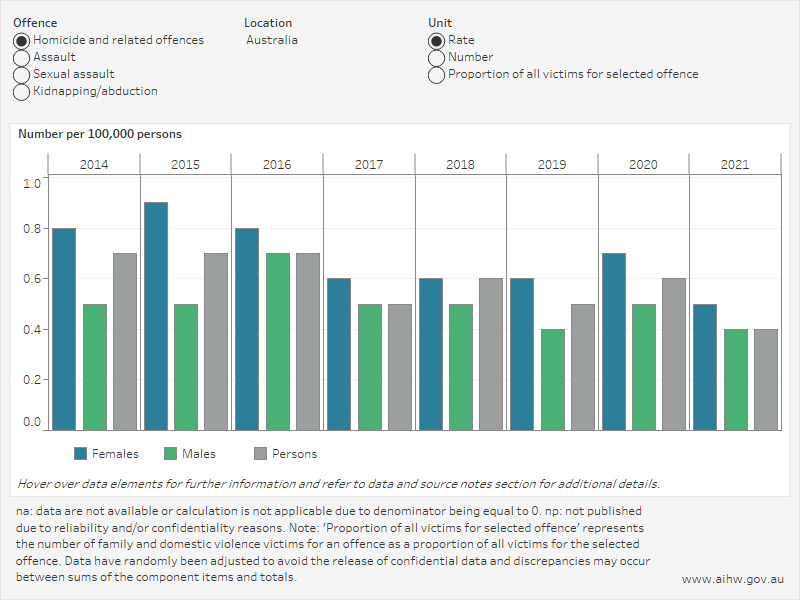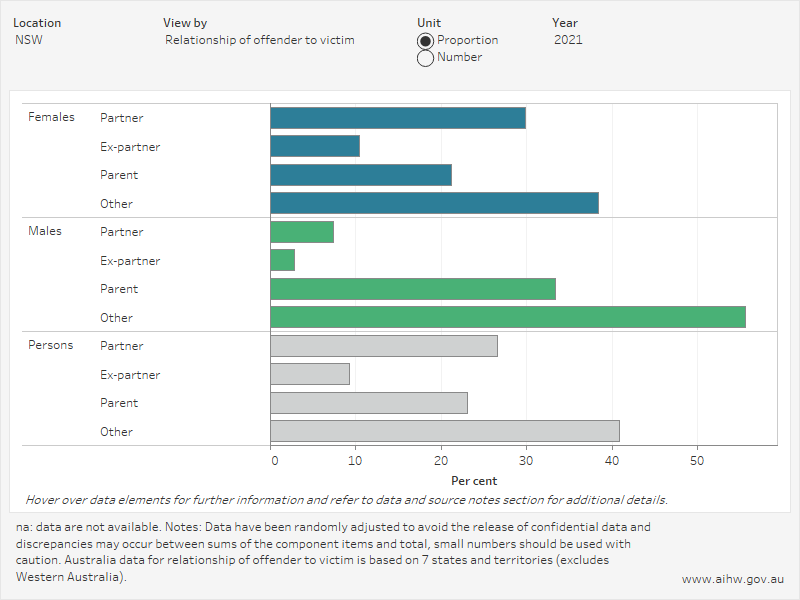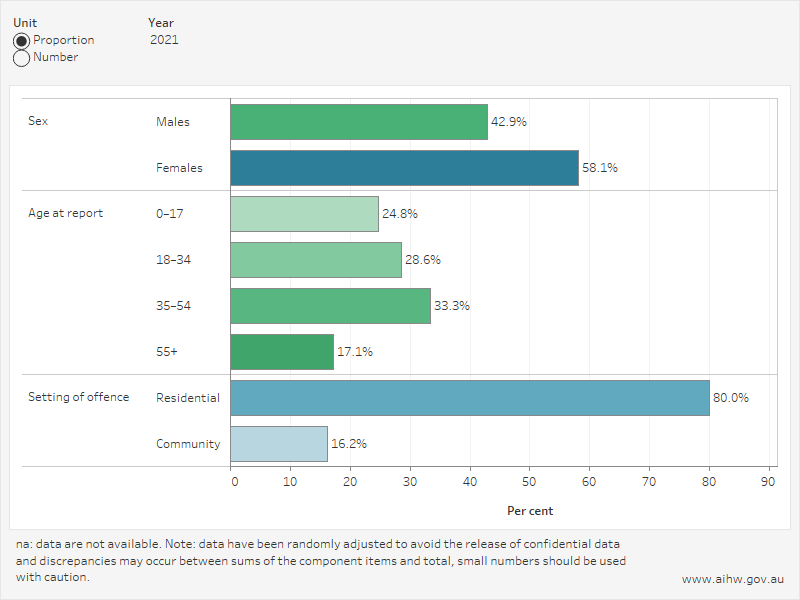Crime rates for family and domestic violence
Incidents of family or domestic violence can be reported to police. Examining crime rates for family and domestic violence makes it possible to compare how often police are engaged in response to incidents of family and domestic violence over time and across different population groups in the Australian community. Data on crime rates for family and domestic violence in Australia are drawn from the ABS Recorded Crime - Victims collection, which is based on crimes reported to police in each state and territory.
The visualisation below allows users to explore crime rates for selected family and domestic violence offences recorded by police per 100,000 people, by sex over time. In Australia, between 2014–2021, the rate of family and domestic violence sexual assault offences increased, with victimisation rates consistently higher for females compared with males. Rates for homicide and related offences fluctuated over time, with the number of offences ranging between 105 and 173 each year. Changes in crime rates may be due to changes in reporting behaviour, increased awareness about forms of violence, changes to police practices, and/or an increase in incidents.
Victims of family and domestic violence crimes, by sex, 2014 to 2021

Indigenous family and domestic violence
The visualisation below allows users to explore the number and rate of Aboriginal and Torres Strait Islander victims of select family and domestic violence offences recorded by police per 100,000 Indigenous Australians, over time for states and territories where data is available. Between 2014–2021, the rate of Indigenous victims of family and domestic violence offences differed across states and territories and by offence type, with rates fluctuating for each jurisdiction over time. Of available data, rates of assault were consistently higher for each jurisdiction than for other offence types examined. For each year examined, over 4 in 5 assault offences were perpetrated by a family member in the Northern Territory, compared with around 1 in 5 in South Australia and 1 in 10 in New South Wales.
Indigenous victims of family and domestic violence crimes, by states and territories, 2014 to 2021

Family and domestic violence sexual assault
The visualisation below allows users to explore the number and proportion of sexual assaults recorded by police, by several characteristics (sex of victim, state and territory in which the incident was reported, age at incident, time to report and relationship of offender to victim). In 2021:
-
Around 1 in 4 (25%) offenders of family and domestic sexual assault were current partners. The proportion of female victims of sexual assaults perpetrated by a current partner (28%) is more than 3 times higher than for male FDV sexual assault (8%).
-
2 in 3 (66% or 7,500) reported sexual assaults were amongst victims aged less than 18 years of age, with the most common age at incident younger for males (57% aged 0–9 at time of incident) than for females (37% aged 10–17 at time of incident).
-
Just over half of all sexual assaults were reported within the first year and around a quarter were not reported for five or more years.
Characteristics of family and domestic violence sexual assaults, 2020 and 2021

Family and domestic assault
The visualisation below allows users to explore the number and proportion of family and domestic assaults recorded by police in 2020 and 2021, by several characteristics (sex of victim, state and territory in which the incident was reported, age at report, setting where crime occurred and relationship of offender to victim). Of those states and territories where data are available, victims aged 25–34 at the time of report accounted for the highest proportion of all victims for most jurisdictions. With the exception of the Northern Territory, the majority of family and domestic assaults occurred in a residential setting. In the Northern Territory, family and domestic assaults were also common in community settings.
Characteristics of family and domestic assaults, 2020 and 2021
Family and domestic homicide
The visualisation below allows users to explore the number and proportion of family and domestic homicides recorded by police, by several characteristics (sex of victim, age at report and setting where crime occurred). It shows that there were more female than male family and domestic homicide victims and these homicides were more likely to happen at a residential address than elsewhere in the community.
Characteristics of family and domestic homicide, 2020 and 2021

Notes
- Victims data does not reflect unique people. If a person is the victim of multiple incidents recorded by police throughout the reference period, each unique incident is counted. Where incidents include multiple offences that fall under different ANZSOC offence categories, each different offence category is counted once per incident.
- Crimes are included in the family and domestic violence-related data in the ABS Recorded Crime – Victims, Australia collection when:
- the relationship of offender to victim, as stored on police recording systems, falls within a specified family or domestic relationship (spouse or domestic partner, parent, child, sibling, boyfriend/girlfriend or other family member to the offender) and/or
- a family domestic violence flag has been recorded, following a police investigation.
- Family and domestic violence victims data in Western Australia is based on the family and domestic violence flag only as relationship of offender to victim information are not recorded. Therefore, some victims of family and domestic violence offences in this jurisdiction may not be included.
- Homicide and related offences includes murder, attempted murder and manslaughter, but excludes driving causing death and conspiracy to murder.
- Assault refers to the direct infliction of force, injury, or violence upon a person or persons, or the direct threat of force, injury, or violence where there is an apprehension that the threat could be enacted. Includes serious assault resulting in injury, serious assault not resulting in injury, and common assault.
- Assault data is not available for Victoria and Queensland, and therefore Australia.
- Sexual assault refers to any physical contact, or intent of contact, of a sexual nature directed toward another person where that person does not give consent, gives consent as a result of intimidation or deception, or consent is unable to be given because of youth, temporary/permanent (mental) incapacity or familial relationship. Sexual assault includes aggravated sexual assault and non-aggravated sexual assault.
- Kidnapping/abduction refers to the unlawful confinement of a person against that person's will, or against the will of any parent, guardian or other person having lawful custody or care of that person. Due to small numbers, these data are not explored separately.
- Total for age-specific visualisations includes victims for whom age was not specified.
- The reported ‘proportion of all victims for selected offence’ represents the number of family and domestic victims for an offence as a proportion of all victims for the selected offence.
- Based on an ABS data quality assessment, Indigenous status data from the Recorded Crime – Victims collection is available for national reporting across 4 states and territories (New South Wales, Queensland, South Australia and the Northern Territory). However, the proportion of victims with an Indigenous status of ‘not stated’ varies by jurisdiction and offence. For more information, see the ABS’ Recorded Crime – Victims methodology.
- Partner includes de facto, spouse, boyfriend and girlfriend.
- Ex-partner includes separated partner, ex-spouse, ex-boyfriend and ex-girlfriend.
- Other includes child, sibling, uncle, aunt, nephew, niece, cousins, grandparents and other family member not elsewhere classified, as well as victims which were flagged by police as FDV–related, but with no other relationship details. May include carer or kinship relationships.
- Community settings includes educational, health, religious, justice, open space and community location not elsewhere classified.
- A small proportion of family and domestic assaults did not occur in a residential or community setting. These are not reported here.
-
For more information see Methods, Glossary and Data sources.


